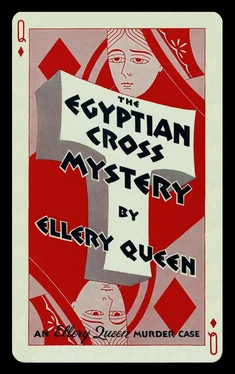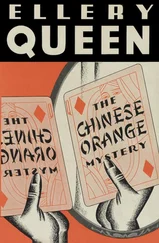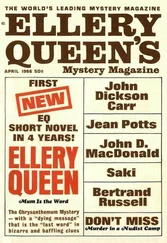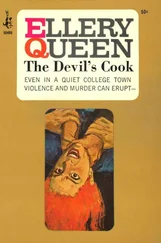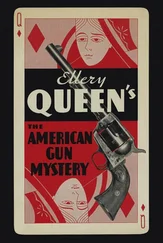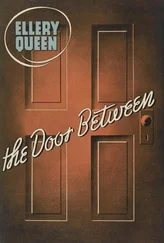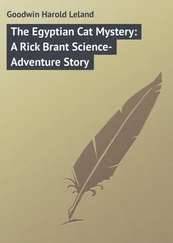A small and frightened bellboy had been pressed into service. He stood before the door, encircled by the group — Ellery, his father, Vaughn, Isham, the Commissioner, Yardley — awaiting the word of command. Ellery looked around; there was no sound except the sound of breathing. Then he nodded grimly to the boy.
The boy gulped and advanced to the door. Two detectives with drawn revolvers stood flat against the panels. One of them knocked briskly. There was no reply; the room, as they could tell from the transom, was in darkness and its occupant probably asleep.
The detective knocked again. This time there was a faint sound from behind the door, and the creaking of bedsprings. A man’s deep voice called out sharply: “Who’s there?”
The bellboy gulped again and cried: “Service, Mr. Chase!”
“What—” They heard the man snort, and the bed creaked again. “I didn’t call for service. What do you want, anyway?” The door opened and a man’s tousled head stuck out...
Of all the incidents that followed — the instant pounce of the two plainclothesmen, the scrambling away of the bellboy, the struggle on the floor, halfway across the threshold — Ellery remembered only one picture. It was in that split second during which no one moved, during which the man took in the scene in the corridor — the waiting officials, the detectives, the uniforms, the faces of Ellery Queen and District Attorney Isham and Inspector Vaughn. The expression of utter stupefaction that was stamped on that white face. The flared nostrils. The distended eyes. The bandage on the wrist of the hand which gripped the jamb...
“Why, it’s... it’s—” Professor Yardley wet his lips twice, and could not find the words.
“It’s as I knew it would be,” drawled Ellery, as he watched the fierce struggle on the floor. “I knew it as soon as I had examined the shack in the hills.”
They managed to subdue Mr. John Chase, of Room 643. A slight dribble of saliva ran from a corner of his mouth. His eyes were wholly mad now.
They were the eyes of the schoolmaster of Arroyo — Andrew Van.
“I’m stumped. I’m absolutely stumped,” snapped Inspector Vaughn. “I can’t get it through my head how a solution was possible from the facts. I’m stumped, Mr. Queen, and you’ll have to convince me that it wasn’t just guesswork.”
“A Queen,” said Ellery severely, “never guesses.”
It was Thursday, and they were seated in a drawing room compartment of the Twentieth Century Limited en route to New York. Yardley and Ellery and Inspector Queen and Isham and Vaughn. A tired but not unhappy party. Their faces betrayed the strain of the nerve-racking experience they had been through — all except, of course, Inspector Queen, who seemed to be enjoying himself in his quiet way.
“You’re not the first,” chuckled the old man to Vaughn. “I’ve never known it to fail. Every time he solves a humdinger somebody wants to know how it was done and says it was guesswork. I’ll be damned if I know myself how he does it most of the time, even after he explains.”
“It’s pure mystery to me,” confessed Isham.
Professor Yardley seemed nettled at the challenge to his intellect. “I’m not an untutored individual,” he growled, as Ellery grinned, “but I’ll hang as high as Haman if I can see how logic applied in this case. It’s been a welter of inconsistencies and contradictions from beginning to end.”
“Wrong,” drawled Ellery. “It was a welter of inconsistencies and contradictions from the beginning to the fourth murder. At that point it became clear as crystal, all the mud decanting off. You see,” he said, knitting his brows, “all along I felt that if I could grasp just one tiny piece and place it in the key position, all the other pieces — so scrambled and illogical in appearance — would take comprehensible shape. That piece was supplied in the West Virginia shack.”
“So you said last night,” grunted the Professor. “And I still can’t see how—”
“Naturally not. You never examined the hut.”
“I did,” snarled Vaughn, “and if you can show me what solved the damned thing—”
“Ah, a challenge. Certainly.” Ellery blew smoke at the low ceiling of the compartment. “Let me go back a bit. Up to the murder in Arroyo Tuesday night, I knew little enough. The first murder in Arroyo was altogether a mystery until Andrew Van himself appeared. He said at that time that his servant Kling had been killed by mistake, that a man named Velja Krosac with blood-motive had been the murderer of this Kling. Thomas Brad, Van’s brother, was murdered. Stephen Megara, Van’s brother, was murdered. Megara had confirmed the story of Krosac, as had the official investigators in Yugoslavia. It all seemed clear enough in its general purport — a monomaniac whose brain had been addled by a lifelong unsatisfied vengeance was running amok among the killers of his father and uncles. When we discovered that the Tvars had also robbed Krosac of his inheritance, an additional motive bolstered the theory.
“I’ve explained to Professor Yardley that there were two definite conclusions to be drawn from the circumstances surrounding the death of Brad. One was that Brad’s murderer was well-known to him; the other that Brad’s murderer did not limp. Is that correct, Professor?” Yardley nodded, and Ellery quickly summarized his reasoning based on the disposition of the checkers and the other facts known to Vaughn and Isham.
“But these conclusions got me nowhere. We had already assumed the possibility of both without conclusive reasoning. The fact that I proved them was therefore of little value. So until I found the body in the shack my only explanation for the queer details of the first three murders was Krosac’s insanity and obsession with a peculiar T phobia — the severing of the heads, the scrawling of the T’s, the very odd T significances surrounding all three crimes.”
Ellery smiled reminiscently and regarded his cigarette with affection. “The astonishing part of it was that very early in the investigation — in fact, seven months ago when I looked upon the first horrible corpse in the Weirton courthouse — a thought struck me which, had I followed it through, might well have terminated the case then and there. It was an alternative explanation for the scattered T’s. It was just a groping thought, the result of my discipline in logic. But it seemed so remote a possibility that I discarded it; and continued to discard it when nothing occurred thereafter to give it the slightest factual support. But it kept persisting...”
“What was that?” asked the Professor with interest. “You recall when we discussed the Egyptian—”
“Ah, let that go,” said Ellery hastily. “I’ll come to it in a moment. Let me first go over the details of the fourth murder.” Rapidly he drew a word-picture of the physical scene that had met his eye when he stepped over the threshold of the barricaded hut just the day before. Yardley and Inspector Queen listened with drawn brows, concentrating on the problem; but when Ellery had finished they regarded each other blankly.
“A perfect vacuum as far as I’m concerned,” confessed the Professor.
“Count me out, too,” said the Inspector.
Vaughn and Isham were looking at Ellery suspiciously.
“Good lord,” cried Ellery, flinging his butt out of the window, “it’s so clear! There’s an epic story written in and around that hut, gentlemen. What’s that motto hanging in the classroom of the School for Scientific Police at the Palais de Justice, Dad? ‘The eye sees in things only what it looks for, and it looks only for what is already in mind.’ Our American police might take that to heart, Inspector Vaughn.
Читать дальше
